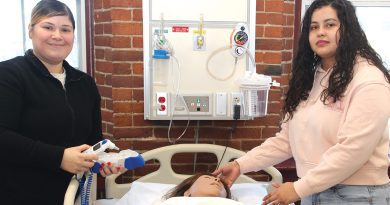New Treatment for Dangerous Food Allergies Elicits Hope
Breathing a Little Easier
About 3.4 million children and 13.6 million adults in the U.S. have been diagnosed with what’s known as immunoglobulin E-mediated (or IgE-mediated) food allergy, causing reactions ranging from mild to moderate (including hives and swelling) to severe and life-threatening, such as anaphylaxis.
More than 40% of children and more than half of adults with food allergies have experienced a severe reaction at least once, and it is estimated that food-related anaphylaxis results in 30,000 medical events treated in emergency rooms in the U.S. each year.
That’s why so many are encouraged by the U.S. Food and Drug Administration’s (FDA) approval of Xolair (omalizumab) injection for immunoglobulin E-mediated food allergy in certain adults and children 1 year or older for the reduction of allergic reactions that may occur with accidental exposure to one or more foods.
Xolair was originally approved in 2003 for the treatment of moderate to severe persistent allergic asthma in certain patients.
“This newly approved use for Xolair will provide a treatment option to reduce the risk of harmful allergic reactions among certain patients with IgE-mediated food allergies,” said Dr. Kelly Stone, associate director of the Division of Pulmonology, Allergy, and Critical Care in the FDA’s Center for Drug Evaluation and Research. “While it will not eliminate food allergies or allow patients to consume food allergens freely, its repeated use will help reduce the health impact if accidental exposure occurs.”
According to the Centers for Disease Control and Prevention, almost 6% of people in the U.S. in 2021 had a food allergy, and exposure to the particular food (or foods) to which they are allergic can lead to potentially life-threatening allergic reactions, such as anaphylaxis.
There is currently no cure for food allergy. Current treatment requires strict avoidance of the food(s) the patient is allergic to and prompt administration of epinephrine to treat anaphylaxis should accidental exposures occur.
Palforzia (peanut allergen powder) is an oral immunotherapy product approved in patients ages 4 to 17 for the mitigation of allergic reactions, including anaphylaxis, that may occur with accidental exposure to peanuts, but its benefits are restricted to peanut allergy. Xolair is the first FDA-approved medication to reduce allergic reactions to more than one type of food after accidental exposure.
“Over the past 35 years, I have seen how debilitating food allergies can be for patients and their loved ones, as they are consumed by the fear of accidental exposure,” said Dr. Robert Wood, director of the Eudowood Division of Allergy, Immunology and Rheumatology at Johns Hopkins Children’s Center and principal investigator of the OUtMATCH study that led to FDA approval.
“While allergic reactions to exposures are common and often severe, there have been limited treatment advancements for food allergy,” he added. “The results of the OUtMATCH study showed that anti-IgE therapy could significantly reduce the occurrence of allergic reactions across multiple foods in the event of an accidental exposure.”
OUtMATCH stands for Omalizumab as Monotherapy and as Adjunct Therapy to Multi-allergen OIT in Food Allergic Children and Adults.
“Living with food allergies has a profound impact on patients and their families, causing significant stress and requiring constant vigilance,” said Dr. R. Sharon Chinthrajah, associate professor of Medicine at Stanford School of Medicine, Sean N. Parker Center for Allergy and Asthma Research, and OUtMATCH co-lead study investigator.
“The OUtMATCH study demonstrated that anti-IgE therapy increased most patients’ threshold for an allergic reaction,” she added. “This presents an important new treatment option for patients and families in its potential to reduce the risk of allergic reactions from accidental exposures they may face in day-to-day life.”
Caution Warranted
As noted, Xolair isn’t a cure, and patients who take it must continue to avoid foods they are allergic to. Xolair is intended for repeated use to reduce the risk of allergic reactions and is not approved for the immediate emergency treatment of allergic reactions, including anaphylaxis. There are 160 different foods that cause IgE-mediated food allergy.
Still, detailed results from the OUtMATCH study showed treatment with Xolair increased, for a majority of trial participants, the amount of peanuts, tree nuts, egg, milk, and wheat they consumed without an allergic reaction, dramatically lessening the results of accidental ingestion or cross-contamination.
Xolair is a drug (in the class of drugs called monoclonal antibodies) that binds to IgE, the antibody type that triggers allergic reactions, and blocks IgE from binding to its receptors.
Xolair’s safety and efficacy in reducing allergic reactions in subjects with food allergies was established in one multi-center, double-blind, placebo-controlled study of 168 pediatric and adult subjects who were allergic to peanut and at least two other foods, including milk, egg, wheat, cashew, hazelnut, or walnut. Researchers randomly gave subjects either Xolair or placebo treatment for 16 to 20 weeks.
The primary measure of Xolair’s efficacy was the percentage of subjects who were able to eat a single dose (600 milligrams or greater) of peanut protein (equivalent to 2.5 peanuts) without moderate to severe allergic symptoms, such as moderate to severe skin, respiratory, or gastrointestinal symptoms, at the end of the treatment course.
Of those who received Xolair, 68% (75 of 110 subjects) were able to eat the single dose of peanut protein without moderate to severe allergic symptoms, compared to 6% (3 of 55 subjects) who received placebo. Of note, however, 17% of subjects receiving Xolair had no significant change in the amount of peanut protein tolerated (they could not tolerate 100 mg or more of peanut protein). As a result, continuation of strict allergen avoidance is still necessary, despite treatment with Xolair.
The key secondary measures of efficacy were the percentage of subjects who were able to consume a single dose (1,000 milligrams or greater) of cashew, milk, or egg protein without moderate to severe allergic symptoms at the end of the treatment course. For cashew, 42% who received Xolair achieved this endpoint, compared to 3% who received placebo.
For milk, 66% who received Xolair achieved this endpoint, compared to 11% who received placebo. For egg, 67% who received Xolair achieved this endpoint, compared to none of the 19 who received placebo. As a result, Xolair treatment is approved for certain patients with one or more IgE-mediated food allergies.
Optimistic Outlook
In the U.S., Genentech and Novartis Pharmaceuticals Corp. have worked together to develop and co-promote Xolair.
“Xolair offers patients and families an important new treatment option that can help redefine the way food allergies are managed and reduce the often-serious allergic reactions that can result from exposure to food allergens,” said Dr. Levi Garraway, Genentech’s chief medical officer and head of Global Product Development. “We look forward to bringing this treatment to the food-allergy community who have long awaited an advancement.”
Other allergy experts are equally hopeful.
“As more and more people are affected by food allergies, the need for a new approach to help prevent serious and often life-threatening allergic reactions and emergencies is critical,” said Sung Poblete, CEO of Food Allergy Research and Education. “As someone with food allergies, I know firsthand the significant impact they can have on people and their loved ones, and I share in the community’s excitement for this approval.”
Kenneth Mendez, president and CEO of the Asthma and Allergy Foundation of America, added that “the stress of living with food allergies can weigh heavily on people and their families, particularly when navigating events like children’s birthday parties, school lunches, and holiday dinners with friends and family. Given the growing prevalence of food allergies, this news offers hope to the many children and adults who may benefit from a new way to help manage their food allergies.”




